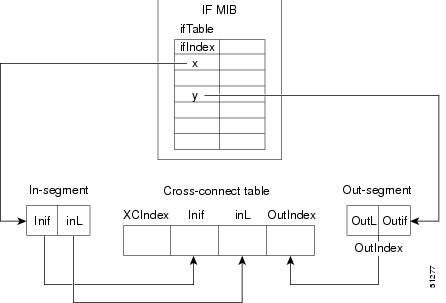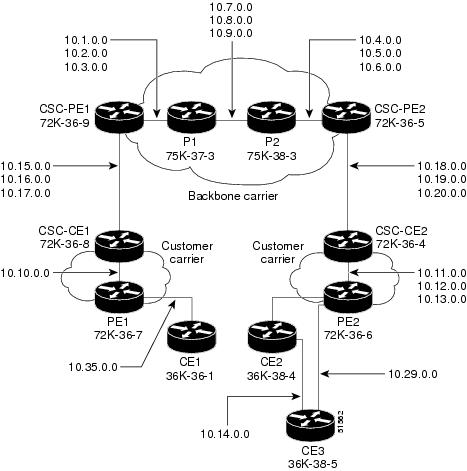ASBR
-- Autonomous System Boundary router. A router that connects one autonomous system to another.
autonomous system
--A collection of networks under a common administration sharing a common routing strategy.
BGP
--Border Gateway Protocol. An interdomain routing protocol that exchanges network reachability information with other BGP
systems (which may be within the same autonomous system or between multiple autonomous systems).
CE router --customer edge router. A router that is part of a customer network and that interfaces to a provider edge (PE) router. CE
routers do not recognize associated MPLS VPNs.
CSC
--Carrier Supporting Carrier. A hierarchical VPN model that allows small service providers, or customer carriers, to interconnect
their IP or MPLS networks over an MPLS backbone. This eliminates the need for customer carriers to build and maintain their
own MPLS backbone.
eBGP
--external Border Gateway Protocol. A BGP between routers located within different autonomous systems. When two routers, located
in different autonomous systems, are more than one hop away from one another, the eBGP session between the two routers is
considered a multihop BGP.
edge router --A router that is at the edge of the network. It defines the boundary of the MPLS network. It receives and transmits packets.
Also referred to as edge label switch router and label edge router.
iBGP
--internal Border Gateway Protocol. A BGP between routers within the same autonomous system.
IGP
--Interior Gateway Protocol. Internet protocol used to exchange routing information within a single autonomous system. Examples
of common Internet IGP protocols include IGRP, OSPF, IS-IS, and RIP.
IP
--Internet Protocol. Network layer protocol in the TCP/IP stack offering a connectionless internetwork service. IP provides
features for addressing, type-of-service specification, fragmentation and reassembly, and security. Defined in RFC 791.
LDP
--Label Distribution Protocol. A standard protocol between MPLS-enabled routers to negotiate the labels (addresses) used to
forward packets.
LFIB
--Label Forwarding Information Base. Data structure used in MPLS to hold information about incoming and outgoing labels and
associated Forwarding Equivalence Class (FEC) packets.
MP-BGP
--Multiprotocol BGP.
MPLS
--Multiprotocol Label Switching. The name of the IETF working group responsible for label switching, and the name of the label
switching approach it has standardized.
NLRI
--Network Layer Reachability Information. The BGP sends routing update messages containing NLRI to describe a route and how
to get there. In this context, an NLRI is a prefix. A BGP update message carries one or more NLRI prefixes and the attributes
of a route for the NLRI prefixes; the route attributes include a BGP next hop gateway address and extended community values.
NSF
--Nonstop forwarding enables routers to continuously forward IP packets following a Route Processor takeover or switchover
to another Route Processor. NSF maintains and updates Layer 3 routing and forwarding information in the backup Route Processor
to ensure that IP packets and routing protocol information are forwarded continuously during the switchover and route convergence
process.
PE router --provider edge router. A router that is part of a service provider’s network. It is connected to a customer edge (CE) router.
All MPLS VPN processing occurs in the PE router.
QoS
--quality of service. Measure of performance for a transmission system that indicates its transmission quality and service
availability.
RD
--route distinguisher. An 8-byte value that is concatenated with an IPv4 prefix to create a unique VPN-IPv4 prefix.
RT
--route target. Extended community attribute used to identify the VRF routing table into which a prefix is imported.
SLA
--Service Level Agreement given to VPN subscribers.
VPN
--Virtual Private Network. A secure MPLS-based network that shares resources on one or more physical networks (typically implemented
by one or more service providers). A VPN contains geographically dispersed sites that can communicate securely over a shared
backbone network.
VRF
--VPN routing and forwarding instance. Routing information that defines a VPN site that is attached to a PE router. A VRF
consists of an IP routing table, a derived forwarding table, a set of interfaces that use the forwarding table, and a set
of rules and routing protocols that determine what goes into the forwarding table.










 Feedback
Feedback